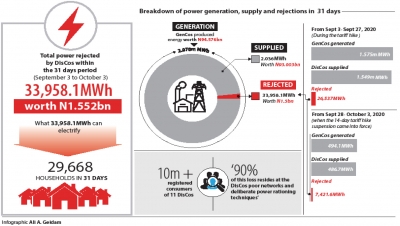News And PoliticsHealth And LifestyleSports And FitnessAgricultureOthersArts And EducationBusiness And MoneyCommunications And EntertainmentRelationship And MarriageStories And PoemsMotivationalsScience And TechnologyIT And Computer ScienceVehicles And MobilityPersonal Care And BeautyFamily And HolidaysFood And Kitchen
profile/6043MEEEE.jpg
Mafroosh12

DisCos Reject N1.5bn Worth Electricity
~2.8 mins read
The 11 Power Distribution Companies (DisCos) could not deliver 33,958.16 megawatts hour (MWh) of energy made available for evacuation by the Generation Companies (GenCos) within one month; from September 1, 2020, when the DisCos hiked electricity tariff by over 80 per cent for certain classes of customers.
The cost is estimated at N1.552bn and it would have benefited over 10 million registered power consumers within 31 days.
The analysis of the electricity rejected covered September 3 to October 3, 2020.
According to data from Eskom, South Africa’s largest power producer, an MWh can energise 650 homes in an hour.
The 33,958.16MWh of energy rejected by the DisCos within the 31 days could have provided electricity to 22.073 million homes in one hour, or put differently, powered 29,668 households for 31 days.
On September 1, 2020, the DisCos rolled out the Service-Based Tariff (SBT) that averagely increased the tariff by over 60 per cent for consumers and claimed power supply of over 12 hours daily.
Further checks show that the tariff hike was approved and duly approved by the Chairman of the Nigerian Electricity Regulatory Commission (NERC), Prof. James Momoh.
NERC explained that the tariff implementation was meant to commit the DisCos to improving services, noting that they would not upgrade the consumers under Bands D and E who were assumed to have below 12-hour power supply daily until the services were improved.
Daily Trust recalls that before the tariff hike early September, most of the DisCos had been complaining of high operations’ costs occasioned by poor income from consumers, hence the need for tariff increase to enable them perform optimally.
The DisCos normally buy electricity from GenCos, but if what transpired in September is anything to go buy, the additional income for the DisCos did not significantly impact on their delivery.
The tariff hike was suspended for two weeks from September 28, after several kicks by the organised labour.
On September 29, NERC directed the DisCos to suspend the tariff hike and revert to the previous template of August 31 till October 11, 2020, when it is expected that the organised labour and the Federal Government would have reached a truce to allow them continue with the re-implementation of the tariff hike.
How DisCos failed to supply N1.5bn worth energy to consumers
Analysis of the unutilised energy records obtained from the Independent System Operator (ISO), a section of the Transmission Company of Nigeria (TCN), indicates that from September 3 – a day before the suspension – to September 27, the power firms had already rejected 26,537MWh of energy estimated at N1.213bn; a deprivation to energy consumers.
The GenCos produced 1,575,369MWh (1.575m MWh) energy from which 1,548,832MWh (1.549m MWh) was sent out for delivery.
However, from September 28, 2020, when the 12-day tariff hike suspension came into force, the DisCos rejected another 7,421.6MWh of energy by October 3, 2020 (Saturday). While GenCos generated 494,114.29MWh energy, the 11 DisCos supplied 486,693.13MWh; leaving the 7,421MWh energy undelivered.
That was a loss of N339.1m worth energy that the consumers could have paid for. At least between 79,000MWh to 101,000MWh of energy was generated daily during the period of this analysis.
The total rejected energy worth estimated at N1.552bn within the one month was reached using a computation of residential consumer tariff as produced by the Abuja Electricity Distribution Company (AEDC).
An MWh is equivalent to 1,000 kilowatts hour (KWh). For residential consumers on the Band A who AEDC said they got over 20 hours daily power supply paid N49.75/KWh. While they pay N49,750/MWh, the 33,958MWh rejected by the 11 DisCos translates to N1.689bn.
Residential consumers on the Band B who AEDC said got 16 to 20 hours daily power supply, paid N47.72/KWh. While they pay N47,720/MWh, the 33,958.16MWh rejected by DisCos translates to N1.620bn.
profile/6043MEEEE.jpg
Mafroosh12

NIMC: National Identity App Not Yet For Public Use
~1.2 mins read
The National Identity Management Commission (NIMC) says the mobile application designed for digital identification is not yet approved for public use.
The application allows citizens to log in with their national identification number (NIN) and registered phone number. After a successful login, the application is expected to display the full details of the citizen, including a photograph.
Some Nigerians who, however, tried to use the app had complained about the flaws — including wrong identities.
Some Nigerians who, however, tried to use the app had complained about the flaws — including wrong identities.
But in a statement on Monday, Kayode Adegoke, spokesman of the commission, said the application is still being tested and once the test is complete, Nigerians would be informed.
“Our attention has been drawn to several complaints about the NIMC mobile App. We will like Nigerians to be aware that the app is a novel innovation by the commission, but it is yet to be officially approved for public consumption,” the statement read.
“The app is still in the test environment and currently being fine-tuned to give users the best experience with adequate privacy and data security safeguards. Once the test stage is concluded, the Commission will issue a formal statement regarding its usage by our esteemed NIN registered persons.
“The app is still in the test environment and currently being fine-tuned to give users the best experience with adequate privacy and data security safeguards. Once the test stage is concluded, the Commission will issue a formal statement regarding its usage by our esteemed NIN registered persons.
“In the same vein, we want to assure Nigerians of the security of their data. Our systems are configured to ensure the utmost protection of the data.
“Members of the general public are hereby strongly advised to disregard commentaries and information from unauthorised sources about the app and other activities of the commission. The official communication platforms of the commission are the only authorised sources of information pertaining to all its activities – press releases; media parley; website and official social media handles.”
“Members of the general public are hereby strongly advised to disregard commentaries and information from unauthorised sources about the app and other activities of the commission. The official communication platforms of the commission are the only authorised sources of information pertaining to all its activities – press releases; media parley; website and official social media handles.”
Advertisement

Link socials
Matches
Loading...
